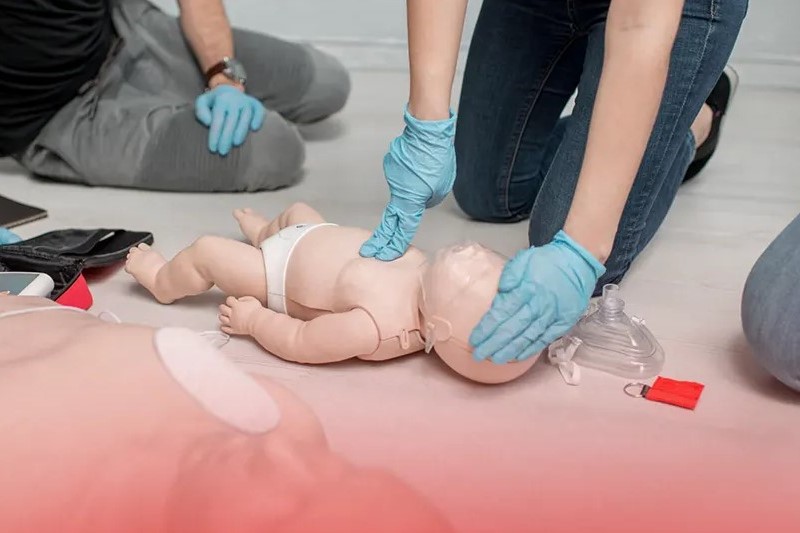
What Is the Difference Between CPR for Infants and Children ?
Cardiopulmonary Resuscitation for infants (Infant CPR) or as we may say babies below 1 year age requires special consideration since they carry the risk of being infected by contagious diseases
So the first step towards CPR for infants is self-protection and universal precautions should be observed for that
For infants below the age of 1 month, their under feet should be tapped or rubbed as they respond well to it.
Shoulders or chest should be rubbed for those above 2 months of age.
In addition, they should be called loudly and tried to be woken up.
They should be closely observed for any kind of movement or sound.
Closely observe the chest movement and listen & feel for breathing by placing your ear close to the baby’s mouth and nose.
Feel the breath on your chin and in case of breathlessness, the breastbone should immediately be pressed by putting on 2 fingers between the baby’s nipples followed by a small push up to one and a half inch and then letting the chest back to its position.
Make sure not to press the very end of breastbone.
This should be repeated twice in a second up to 30 times.
The procedure should be repeated for 2 minutes followed by 2 rescue breaths.
The breaths should be given by closing the nostrils that should make the chest rise.
This procedure should be repeated until further help arrives or when baby starts breathing again.
In case of uncertainty whether the baby is breathing or not, CPR should preferably be performed instead of not carrying it out assuming the condition to be stable and while doing it, the baby’s head should be kept tilted back.
The tongue should be moved away from the windpipe by lifting the infant’s chin with the head still tilted back.
In case of a suspected spinal injury, moving the head or neck should be avoided and only jaw should be pulled forward without letting the mouth close.
The major reasons that contribute to stoppage of heartbeat and breathing might be choking, electric shock, suffocation, head trauma, blood loss or poisoning that may lead to unconsciousness.
Brain damage may be permanent if oxygen supply is depleted for 4 minutes followed by death in later 4-6 minutes.
Infant CPR
CPR in infants should be carried out with a lot of care and precision using only two fingers, the index and the middle finger with the other hand on the forehead bringing the subject into sniffer’s position.
Once the baby restores breath, CPR should be stopped immediately.
Continuing it may cause the heart to stop functioning due to stress overload.
All this procedure however can never be a substitute for proper CPR training.
Read Also
Emergency Live Even More…Live: Download The New Free App Of Your Newspaper For IOS And Android
How To Use An AED On A Child And An Infant: The Paediatric Defibrillator
First Aid: Identify The 8 Common Symptoms Of A Heart Attack In Women
Neonatal CPR: How To Perform Resuscitation On An Infant
Cardiac Arrest: Why Is Airway Management Important During CPR?
5 Common Side Effects Of CPR And Complications Of Cardiopulmonary Resuscitation
All You Need To Know About Automated CPR Machine: Cardiopulmonary Resuscitator / Chest Compressor
European Resuscitation Council (ERC), The 2021 Guidelines: BLS – Basic Life Support
Paediatric Implantable Cardioverter Defibrillator (ICD): What Differences And Peculiarities?
Pediatric CPR: How To Perform CPR On Pediatric Patients?
Cardiac Abnormalities: The Inter-Atrial Defect
What Are Atrial Premature Complexes?
ABC Of CPR/BLS: Airway Breathing Circulation
What Is Heimlich Maneuver And How To Perform It Correctly?
First Aid: How To Do The Primary Survey (DR ABC)
How To Carry Out Primary Survey Using The DRABC In First Aid
What Should Be In A Paediatric First Aid Kit
Does The Recovery Position In First Aid Actually Work?
Supplemental Oxygen: Cylinders And Ventilation Supports In The USA
Heart Disease: What Is Cardiomyopathy?
Defibrillator Maintenance: What To Do To Comply
Defibrillators: What Is The Right Position For AED Pads?
When To Use The Defibrillator? Let’s Discover The Shockable Rhythms
Who Can Use The Defibrillator? Some Information For Citizens
Defibrillator Maintenance: AED And Functional Verification
Myocardial Infarction Symptoms: The Signs To Recognise A Heart Attack
What Is The Difference Between Pacemaker And Subcutaneous Defibrillator?
What Is An Implantable Defibrillator (ICD)?
What Is A Cardioverter? Implantable Defibrillator Overview
Paediatric Pacemaker: Functions And Peculiarities
Chest Pain: What Does It Tell Us, When To Worry?
Cardiomyopathies: Definition, Causes, Symptoms, Diagnosis And Treatment
Aortic Valve Surgery: An Overview
Aorta Surgery: What It Is, When It Is Essential
Abdominal Aortic Aneurysm: Symptoms, Evaluation And Treatment
Coronary Artery Bypass Surgery: What It Is And When To Use It
Do You Have To Face Surgery? Post-Surgery Complications
What Is Aortic Regurgitation? An Overview
Diseases Of The Valves Of The Heart: Aortic Stenosis
Interventricular Septal Defect: What It Is, Causes, Symptoms, Diagnosis, And Treatment
Heart Disease: The Atrial Septal Defect
Interventricular Defect: Classification, Symptoms, Diagnosis And Treatment
Arrhythmias: The Alterations Of The Heart
Identifying Tachycardias: What It Is, What It Causes And How To Intervene On A Tachycardia
Cardiac Rhythm Disturbance Emergencies: The Experience Of US Rescuers
Cardiomyopathies: Definition, Causes, Symptoms, Diagnosis And Treatment
Spontaneous Coronary Artery Dissection, Which Heart Disease Is Associated With
CPR Vs Rescue Breathing: The Basic Resuscitation Difference



